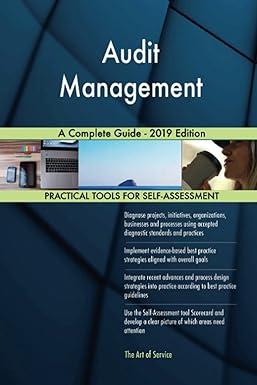Question
please help me out 1) Lease or Sell Kincaid Company owns a equipment with a cost of $361,600 and accumulated depreciation of $53,000 that can
please help me out
1) Lease or Sell
Kincaid Company owns a equipment with a cost of $361,600 and accumulated depreciation of $53,000 that can be sold for $275,900, less a 5% sales commission. Alternatively, Kincaid Company can lease the equipment to another company for three years for a total of $285,400, at the end of which there is no residual value. In addition, the repair, insurance, and property tax expense that would be incurred by Kincaid Company on the equipment would total $15,000 over the three years.
Prepare a differential analysis on March 23 as to whether Kincaid Company should lease (Alternative 1) or sell (Alternative 2) the equipment. For those boxes in which you must enter subtracted or negative numbers use a minus sign.
| Differential Analysis | |||
| Lease Equipment (Alt. 1) or Sell Equipment (Alt. 2) | |||
| March 23 | |||
| Lease Equipment (Alternative 1) | Sell Equipment (Alternative 2) | Differential Effect on Income (Alternative 2) | |
| Revenues | $ | $ | $ |
| Costs | |||
| Income (Loss) | $ | $ | |
2)
Discontinue a Segment
Product A has revenue of $194,900, variable cost of goods sold of $113,400, variable selling expenses of $33,900, and fixed costs of $59,700, creating a loss from operations of $12,100.
Prepare a differential analysis as of May 9, to determine whether Product A should be continued (Alternative 1) or discontinued (Alternative 2), assuming fixed costs are unaffected by the decision. If an amount is zero, enter "0". For those boxes in which you must enter subtracted or negative numbers use a minus sign.
| Differential Analysis | |||
| Continue Product A (Alt. 1) or Discontinue Product A (Alt. 2) | |||
| May 9 | |||
| Continue Product A (Alternative 1) | Discontinue Product A (Alternative 2) | Differential Effect on Income (Alternative 2) | |
| Revenues | $ | $ | $ |
| Costs: | |||
| Variable cost of goods sold | |||
| Variable selling expenses | |||
| Fixed costs | |||
| Income (Loss) | $ | $ | $ |
3)
Make or Buy
A restaurant bakes its own bread for a cost of $160 per unit (100 loaves), including fixed costs of $35 per unit. A proposal is offered to purchase bread from an outside source for $104 per unit, plus $12 per unit for delivery.
Prepare a differential analysis dated July 7 to determine whether the company should make (Alternative 1) or buy (Alternative 2) the bread, assuming that fixed costs are unaffected by the decision. If an amount is zero, enter "0". For those boxes in which you must enter subtracted or negative numbers use a minus sign.
| Differential Analysis | |||
| Make Bread (Alt. 1) or Buy Bread (Alt. 2) | |||
| July 7 | |||
| Make Bread (Alternative 1) | Buy Bread (Alternative 2) | Differential Effect on Income (Alternative 2) | |
| Sales price | $0 | $0 | $0 |
| Unit Costs: | |||
| Purchase price | $ | $ | $ |
| Delivery | |||
| Variable costs | |||
| Fixed factory overhead | |||
| Income (Loss) | $ | $ | $ |
Step by Step Solution
There are 3 Steps involved in it
Step: 1

Get Instant Access to Expert-Tailored Solutions
See step-by-step solutions with expert insights and AI powered tools for academic success
Step: 2

Step: 3

Ace Your Homework with AI
Get the answers you need in no time with our AI-driven, step-by-step assistance
Get Started


